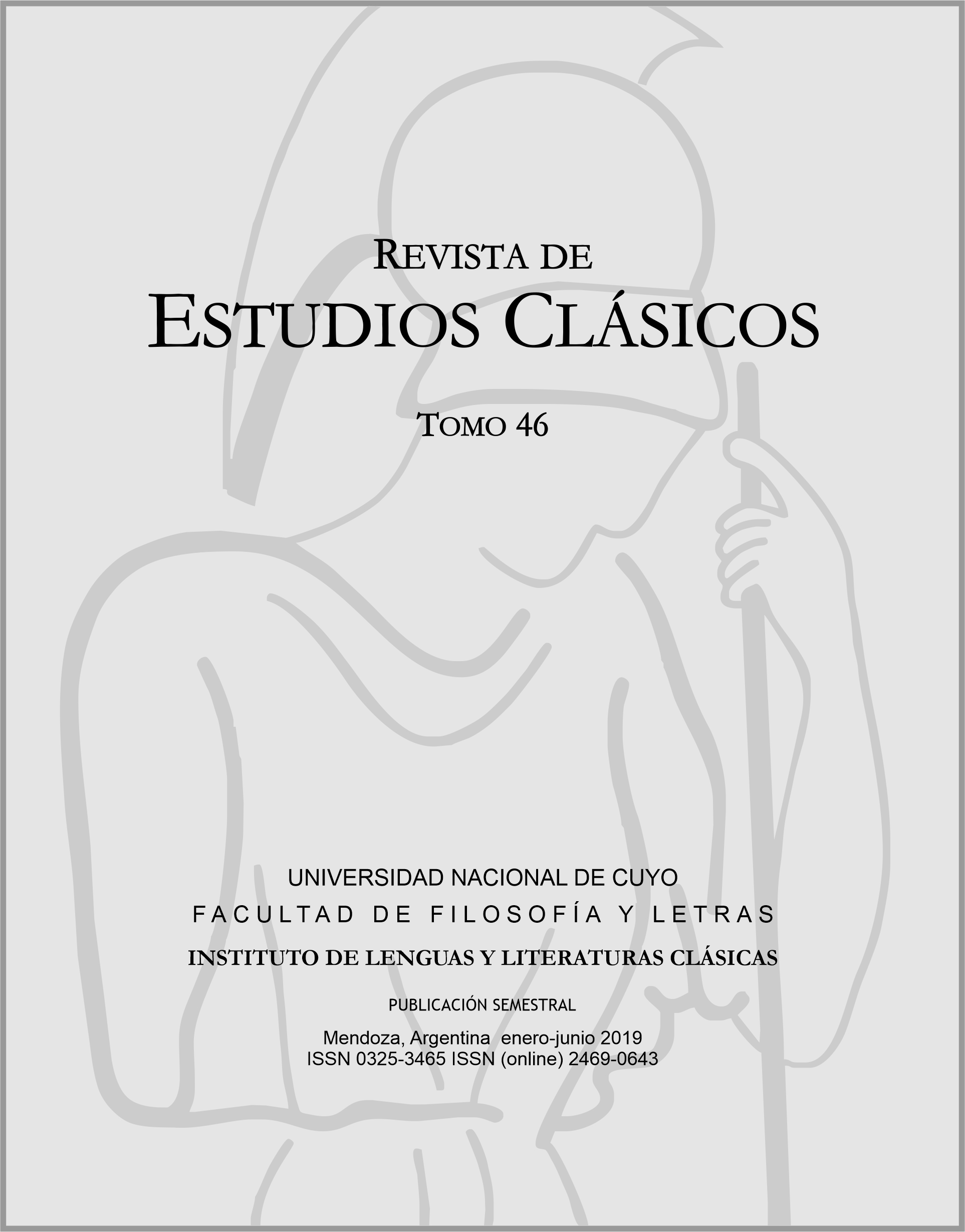La navigatio Sancti Brendani Abbatis: Eneas en el Medioevo
Palabras clave:
Eneas, San Brandán, viaje, conductor, paraíso, trasmundoResumen
El estudio se centra en dos cuestiones fundamentales de ambos relatos: la condición de dux del protagonista (Eneas y San Brandán,
respectivamente) y el itinerario simbólico hacia la tierra prometida. El análisis se sitúa en un plano en que el símbolo importa más que el dato
de la realidad, aun cuando este dato sea indispensable para la cabal compresión del viaje.
Se observa una coincidencia profunda en la trayectoria de ambos personajes como símbolo de un itinerario espiritual complejo que parte
del desconocimiento o del conocimiento imperfecto, progresa atendiendo un recorrido ritual y transita sucesivas pruebas que
robustecen la pietas y la uirtus de los peregrinos. A través de una muerte virtual, representada por el pasaje del trasmundo infernal, se logran
superar las contingencias ordinarias para percibir la auténtica dimensión de los trabajos sub specie aeternitatis.
Citas
Benedeit (1983). El viaje de San Brandán. Madrid: Siruela. Chevalier, J. / Gheerbrant, A. (1982). Dictionnaire des symboles. París: Éditions Robert Laffont.
Corbella, D. (1991). El viaje de San Brandán: una aventura de iniciación. Filología Románica 8, pp. 133-147.
Dauge, Y. A. (1984). Virgile. Maître de Sagesse. Milan: Archè.
De Goeje, M. J. (1891). La Légende de saint Brandan. Actes du Huitième Congrès International des Orientalistes tenu en 1889 à Stockholm et à Christiana, Leiden, Brill, pp. 43-76.
Esposito, M. (1938). Sur la Navagatio sancti Brendani et sur les versions italiennes de la Navagatio. Romania 64, pp. 328–346.
Esposito, M. (1960). An apocryphal Book of Enoch and Elias as a possible source of the Navigatio sancti Brendani, reed. en Wooding, J. (ed.) (2000). The Otherworld Voyage in Early Irish literature: an anthology of criticism, Dublin: Four Courts Press, pp. 27-41.
Esposito, M. (1961). L'édition de la Navigatio S. Brendani, Scriptorium 15, pp. 286-292.
Kenney, J. F. (1920). The legend of St. Brendan, Royal Society of Canada. Proceedings and Transactions 14, pp. 51-67.
Lemarchand, M. J. (1983). Prólogo. En: Beneit. El viaje de San Brandán. Madrid: Siruela.
Mackley, J. S. (2008). The Legend of St Brendan: A Comparative Study of the Latin and Anglo-Norman Versions. Leiden: Brill.
Martínez, M. (1998). El mito de la isla perdida y su tradición en la historia, cartografía, literatura y arte. Revista de Filología de la Universidad de La Laguna 16, pp. 143-184.
Mynors, R. A. B. (ed.) (1969). Vergili Maronis. Opera. Oxford: OUP.
Ozanam, F. A. (1845). Dante et la philosophie Catholique au trezième siècle. Paris: Jacques Lecoffre et Cie.
Paschoud, F. (1967). Roma aeterna. Roma: Institut Suisse de Rome.
Patch, H. R. (1956). El otro mundo en la literatura medieval. México-Buenos Aires: FCE.
Plummer, C. (1905). Some New Light on the Brendan Legend. Zeitschrift für Celtische Philologie 5, pp. 124–141.
Rowland, R. Jr. (1971). Aeneas as a heroe in Twelfh-Century Ireland. Vergilius 16, pp. 2932.
Selmer, C. (1949). The origin of Brandenburg (Prussia): the saint Brendan legend and the Scoti of the tenth century. Traditio 7, pp. 416-433.
Selmer, C. (ed.) (1959). Navigatio Sancti Brendani Abbatis from early Latin manuscripts. New York: University of Notre Dame Press.
Zimmer, H. (1889). Keltische Beitrage. Brendans Meerfahrt. Zeitschrift für Deutsches Alterthum 33, pp. 129–220, 257–338.
Descargas
Cómo citar
Número
Sección
Licencia
Aquellos autores/as que tengan publicaciones con esta revista, aceptan los términos siguientes:
- Los autores/as conservarán sus derechos de autor y garantizarán a la revista el derecho de primera publicación de su obra, el cuál estará simultáneamente sujeto a laLicencia Creative Commons Atribución-NoComercial-CompartirIgual 2.5 Argentina (CC BY-NC-SA 2.5 AR). (https://creativecommons.org/licenses/by-nc-sa/2.5/ar/)que permite a terceros compartir la obra siempre que se indique su autor y su primera publicación esta revista.
- Los autores/as podrán adoptar otros acuerdos de licencia no exclusiva de distribución de la versión de la obra publicada (p. ej.: depositarla en un archivo telemático institucional o publicarla en un volumen monográfico) siempre que se indique la publicación inicial en esta revista.
- Se permite y recomienda a los autores/as difundir su obra a través de Internet (p. ej.: en archivos telemáticos institucionales o en su página web) antes y durante el proceso de envío, lo cual puede producir intercambios interesantes y aumentar las citas de la obra publicada. (Véase El efecto del acceso abierto).


































